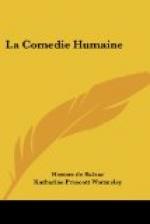|
This section contains 11,662 words (approx. 39 pages at 300 words per page) |

|
SOURCE: Goulet, Andrea. “‘Tomber dans le phénomène’: Balzac's Optics of Narration.” French Forum 26, no. 3 (fall 2001): 43-70.
In the following essay, Goulet explores the dual narrative modes of vision and sight, or mystical revelation and scientific observation, in La Comédie humaine, showing how images of the eye and seeing, as well as ideas about spiritual seeking and inner vision, permeate Balzac's novels.
Traditional distinctions between romantic and realist fiction in nineteenth-century France invoke a direct relation between narrative form and authorial vision: the poetic thrust of the romantic novel implies a visionary eye, attuned to the realm of mystical revelation, while the descriptive logic of the realist novel implies a scientific eye, trained for the positivist observation of details in the world. One need only read the titles of two well-known critical works on Hugo and Zola to recognize the competing poles of visuality at stake...
|
This section contains 11,662 words (approx. 39 pages at 300 words per page) |

|


